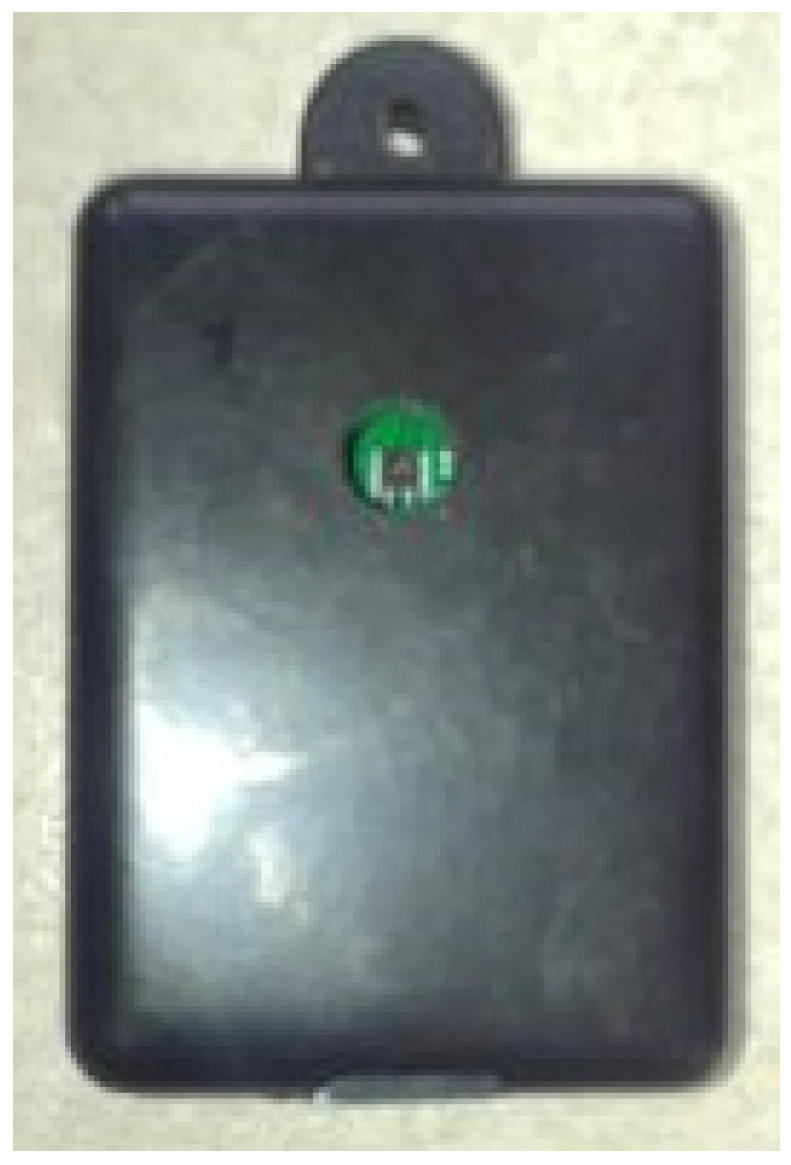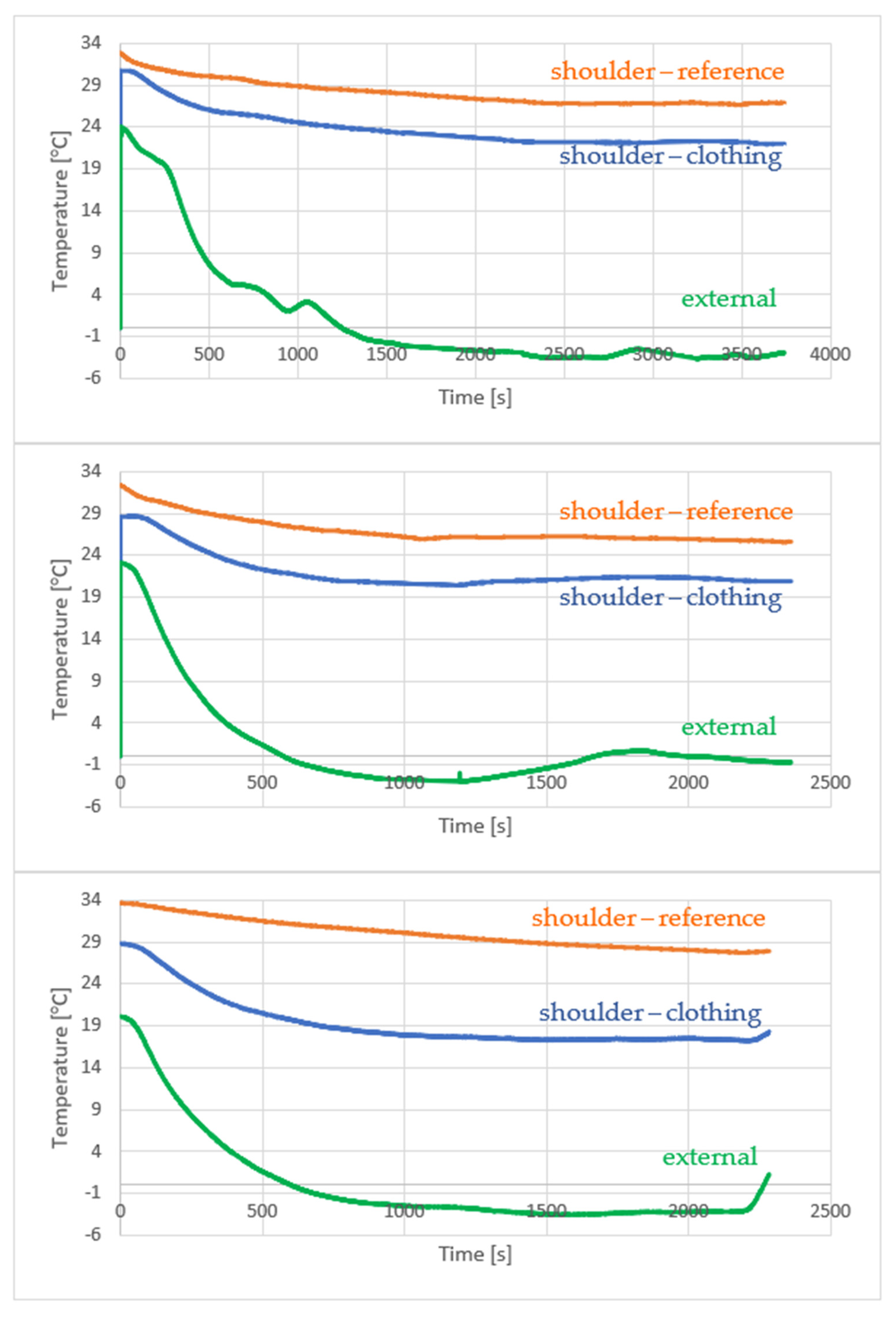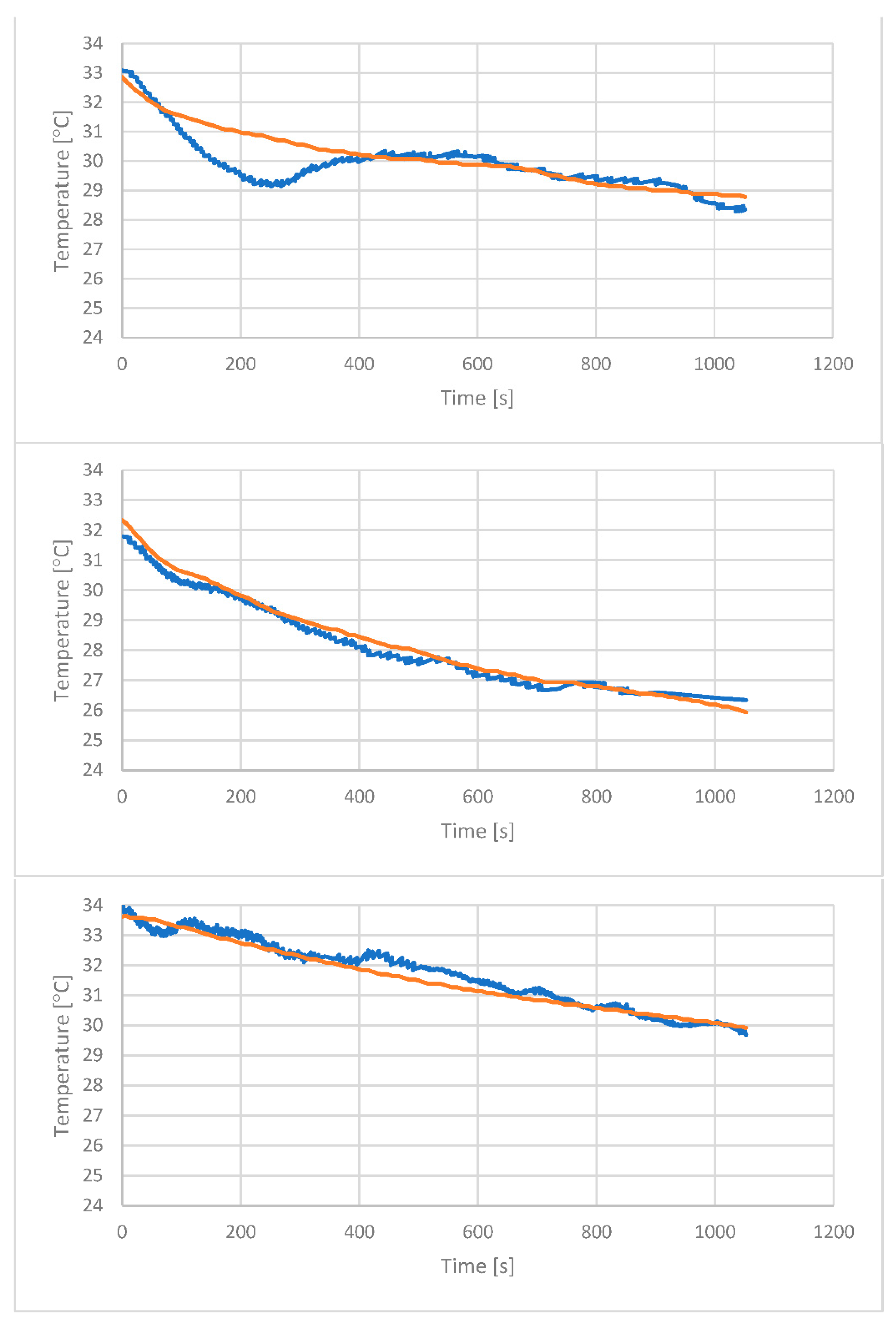A Thermal Model for Processing Data from Undergarment Sensors in Automatic Control of Actively Heated Clothing
Abstract
:1. Introduction
1.1. Motivation
1.2. Aim
- Investigate the magnitude of errors introduced by the proposed setup;
- Determine whether the type of underclothing has a significant influence on these errors; and
- Establish a reliable thermal model that allows the automatic algorithm to correctly use the temperature data from undergarment sensors.
1.3. State-of-the-Art
2. Materials and Methods
2.1. Overview of the System
- Adherence to typical placement used for the estimation of mean skin temperature over the body, according to IEC norm ISO 9886 (left palm, right shin, nape, right scapula) [15];
- The requirements of functional convenience indicated by the end users—in particular, some locations must be excluded because they interfere with rescuers’ equipment such as backpack, harness, etc.; and
- Ability to gather data about local thermal comfort of different parts of the body.
2.2. Clothing
2.3. Sensors and Insets
2.4. Embedded System
2.5. Mobile Application
2.6. Backend and Frontend Web Applications
3. The Experiment
4. Results
- Reference sensor—the iButton skin temperature and humidity sensor;
- Clothing sensor—the sPParTAN project undergarment temperature and humidity sensor;
- External sensor—the sPParTAN project external temperature and pressure sensor.
- A significant discrepancy was observed between the temperatures reported by the clothing and reference sensors. This discrepancy varies in time and differed between participants A, B and C.
- The temperature readouts for the instant in time when the participants first reported “too cold” vary between participants, as indicated by both the clothing and the reference sensors.
- It takes approximately 40 min from entering the chamber for the skin temperature to reach a steady state, as indicated by the reference sensor of participant A. Note that the almost flat response for participant B, starting from minute 18, is not due to reaching the steady state, but is due to some rise in ambient temperature influencing the sensor response.
- The external temperature sensor responds to air temperature changes with a significant delay. In an ideal case, its reading should drop to the air temperature of the chamber (−5 °C) immediately upon entrance of the participant into the chamber; instead, it takes between 9 and 10 min to reach a readout of 0 °C. Note that for participant A, the external temperature curve is not smooth and the time to reach 0 °C is 20 min—this may indicate that the air temperature in the chamber was not uniform and the participant moved around the chamber.
5. Discussion
5.1. Effect of In-Clothes Sensor Placement
5.2. Effect of Sensor Construction
5.3. Complete Thermal Model
5.4. Model Evaluation
6. Conclusions
Author Contributions
Funding
Informed Consent Statement
Data Availability Statement
Conflicts of Interest
References
- Bellis, M. History of the Electric Blanket. Available online: https://www.thoughtco.com/history-of-the-electric-blanket-1991596 (accessed on 24 November 2021).
- Do You Know the History of Electric Heating Pad? Available online: https://www.bstherm.com/info/do-you-know-the-history-of-electric-heating-pa-17986318.html (accessed on 24 November 2021).
- Scott, R.A. The Technology of Electrically Heated Clothing. Ergonomics 1988, 31, 1065–1081. [Google Scholar] [CrossRef]
- Marick, L.; Farms, G.P. Electrically Heated Wearing Apparel. U.S. Patent No. 2 277 772, 31 March 1942. [Google Scholar]
- Peng, L.; Su, B.; Yu, A.; Jiang, X. Review of Clothing for Thermal Management with Advanced Materials. Cellulose 2019, 26, 6415–6448. [Google Scholar] [CrossRef]
- Peng, Y.; Sun, F.; Xiao, C.; Iqbal, M.I.; Sun, Z.; Guo, M.; Gao, W.; Hu, X. Hierarchically Structured and Scalable Artificial Muscles for Smart Textiles. ACS Appl. Mater. Interfaces 2021, 13, 54386–54395. [Google Scholar] [CrossRef]
- Atalie, D.; Tesinova, P.; Tadesse, M.G.; Ferede, E.; Dulgheriu, I.; Loghin, E. Thermo-Physiological Comfort Properties of Sportswear with Different Combination of Inner and Outer Layers. Materials 2021, 14, 6863. [Google Scholar] [CrossRef] [PubMed]
- Zhao, Y.; Li, L. Novel Design of Integrated Thermal Functional Garment for Primary Dysmenorrhea Relief: The Study and Customizable Application Development of Thermal Conductive Woven Fabric. Text. Res. J. 2020, 90, 1002–1023. [Google Scholar] [CrossRef]
- Wang, F.; Gao, C.; Kuklane, K.; Holmér, I. A Review of Technology of Personal Heating Garments. Int. J. Occup. Saf. Ergon. JOSE 2010, 16, 387–404. [Google Scholar] [CrossRef] [PubMed] [Green Version]
- Heated Glove Liners, Gloves, Jackets + More|ActiVHeat. Available online: https://www.activheat.com/ (accessed on 24 November 2021).
- Battery Heated Clothing Delivers Active Heat When You Need It. With Rechargeable Battery Technology It Is Easy to Choose between Different Heating Levels. Available online: https://heatexperience.eu/ (accessed on 24 November 2021).
- Heated Clothing, Heated Jackets, Heated Gloves, Heated Socks, Heated Vests|The Warming Store. Available online: https://www.thewarmingstore.com/ (accessed on 24 November 2021).
- Heated Clothing Offers Consumers New Options | MAXHEAT Project | Results in Brief | H2020 | CORDIS | European Commission. Available online: https://cordis.europa.eu/article/id/428945-heated-clothing-offers-consumers-new-options (accessed on 24 November 2021).
- Fanger, P.O. Thermal Comfort. In Analysis and Applications in Environmental Engineering; Danish Technical Press: Copenhagen, Denmark, 1970. [Google Scholar]
- Parsons, K. Human Thermal Environments: The Effects of Hot, Moderate, and Cold Environments on Human Health, Comfort, and Performance, 3rd ed.; CRC Press: Boca Raton, FL, USA, 2014; ISBN 978-1-4665-9600-9. [Google Scholar]
- Rohles, F.H., Jr.; Nevins, R.G. The Nature of Thermal Comfort for Sedentary Man. ASHRAE Trans. 1971, 77, 239–246. [Google Scholar]
- Gagge, A.P.; Gonzalez, R.R. Magnitude Estimates of Thermal Discomfort During Transients of Humidity and Operative Temperature and Their Relation to the New ASHRAE Effective Temperature (ET*). ASHRAE Trans. 1973, 79, 88–96. [Google Scholar]
- MacRae, B.A.; Annaheim, S.; Spengler, C.M.; Rossi, R.M. Skin Temperature Measurement Using Contact Thermometry: A Systematic Review of Setup Variables and Their Effects on Measured Values. Front. Physiol. 2018, 9, 29. [Google Scholar] [CrossRef] [Green Version]
- Li, H.; Yang, H.; Li, E.; Liu, Z.; Wei, K. Wearable Sensors in Intelligent Clothing for Measuring Human Body Temperature Based on Optical Fiber Bragg Grating. Opt. Express 2012, 20, 11740–11752. [Google Scholar] [CrossRef] [Green Version]
- Hudec, R.; Matuska, S.; Kamencay, P.; Hudecova, L. Concept of a Wearable Temperature Sensor for Intelligent Textile. Adv. Electr. Electron. Eng. 2020, 18, 92–98. [Google Scholar] [CrossRef]
- Root, W.; Bechtold, T.; Pham, T. Textile-Integrated Thermocouples for Temperature Measurement. Materials 2020, 13, 626. [Google Scholar] [CrossRef] [PubMed] [Green Version]
- Lugoda, P.; Costa, J.C.; Oliveira, C.; Garcia-Garcia, L.A.; Wickramasinghe, S.D.; Pouryazdan, A.; Roggen, D.; Dias, T.; Münzenrieder, N. Flexible Temperature Sensor Integration into E-Textiles Using Different Industrial Yarn Fabrication Processes. Sensors 2020, 20, 73. [Google Scholar] [CrossRef] [PubMed] [Green Version]
- Capacitor by Ionic—Cross-Platform Apps with Web Technology. Available online: https://capacitorjs.com/ (accessed on 24 November 2021).
- Neff, W.D. Contributions to Sensory Physiology: Volume 4; Academic Press: New York, NY, USA, 1970; ISBN 978-1-4831-9157-7. [Google Scholar]
- Fiala, D. Dynamic Simulation of Human Heat Transfer and Thermal Comfort. Ph.D. Thesis, De Montfort University, Leicester, UK, 1998. [Google Scholar]
- Clark, R.P.; Edholm, O.G. Man and His Thermal Environment; Edward Arnold: London, UK, 1985; ISBN 978-0-7131-4445-1. [Google Scholar]
- Lasdon, L.S.; Waren, A.D.; Jain, A.; Ratner, M. Design and Testing of a Generalized Reduced Gradient Code for Nonlinear Programming. ACM Trans. Math. Softw. 1978, 4, 34–50. [Google Scholar] [CrossRef]












| Sensor | Measured Parameter | Resolution | Range | Accuracy |
|---|---|---|---|---|
| Bosch BMP280 | External temperature | 0.01 °C | −40 … +85 °C | ±0.5 °C |
| Pressure | 0.16 Pa | 300 … 1100 hPa | ±1 hPa | |
| Sensirion SHTC3 | Temperature | 0.01 °C | −40 … +125 °C | ±0.2 °C |
| Humidity | 0.01% RH | 0 … 100% RH | ±2.0% RH |
| Stage | Task |
|---|---|
| 1 | Don the clothes, including the Gore-Tex jacket. |
| 2 | Enter the chamber. |
| 3 | Stand still until “too cold” sensation is experienced in all zones or the temperature sensation becomes stable. |
| 4 | Turn on heating insets. |
| 5 | Stand still and adjust the heating level until a “comfortable” sensation is experienced in all zones or, if this cannot be attained, the temperature sensation becomes stable. |
| 6 | Set the heating level to maximum. |
| 7 | Stand still until “too hot” sensation is experienced in all zones, or the temperature sensation becomes stable or the heat sensation is significantly unpleasant in any zone. |
| 8 | Turn off the heating insets. |
| 9 | Stand still until a “comfortable” or “too cold” sensation is experienced in all zones or the temperature sensation becomes stable. |
| 10 | Exit the chamber. |
| Participant | Age | Height | Weight |
|---|---|---|---|
| A | 36 | 188 cm | 85 kg |
| B | 40 | 172 cm | 65 kg |
| C | 46 | 179 cm | 76 kg |
| Parameter | Value |
|---|---|
| Rx·Cx | 300 s |
| Rnm·Cnm | 31 s |
| Rne·Cne | 249 s |
| a/(a + 2)—participant A | 0.17 |
| a/(a + 2)—participant B | 0.2 |
| a/(a + 2)—participant C | 0.375 |
| Participant | Time to Reach | Reference Temperature | Model Temperature | Difference |
|---|---|---|---|---|
| A | 2070 s | 27.27 °C | 27.61 °C | −0.34 °C |
| B | 372 s | 28.62 °C | 28.33 °C | 0.29 °C |
| C | 485 s | 31.52 °C | 31.96 °C | −0.44 °C |
Publisher’s Note: MDPI stays neutral with regard to jurisdictional claims in published maps and institutional affiliations. |
© 2021 by the authors. Licensee MDPI, Basel, Switzerland. This article is an open access article distributed under the terms and conditions of the Creative Commons Attribution (CC BY) license (https://creativecommons.org/licenses/by/4.0/).
Share and Cite
Tylman, W.; Kotas, R.; Kamiński, M.; Woźniak, S.; Dąbrowska, A. A Thermal Model for Processing Data from Undergarment Sensors in Automatic Control of Actively Heated Clothing. Energies 2022, 15, 169. https://doi.org/10.3390/en15010169
Tylman W, Kotas R, Kamiński M, Woźniak S, Dąbrowska A. A Thermal Model for Processing Data from Undergarment Sensors in Automatic Control of Actively Heated Clothing. Energies. 2022; 15(1):169. https://doi.org/10.3390/en15010169
Chicago/Turabian StyleTylman, Wojciech, Rafał Kotas, Marek Kamiński, Sebastian Woźniak, and Anna Dąbrowska. 2022. "A Thermal Model for Processing Data from Undergarment Sensors in Automatic Control of Actively Heated Clothing" Energies 15, no. 1: 169. https://doi.org/10.3390/en15010169
APA StyleTylman, W., Kotas, R., Kamiński, M., Woźniak, S., & Dąbrowska, A. (2022). A Thermal Model for Processing Data from Undergarment Sensors in Automatic Control of Actively Heated Clothing. Energies, 15(1), 169. https://doi.org/10.3390/en15010169







